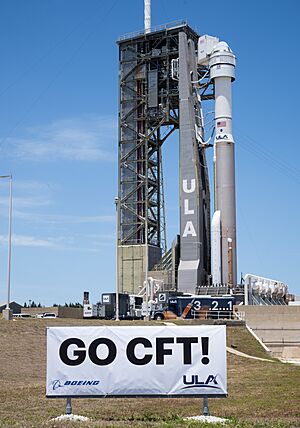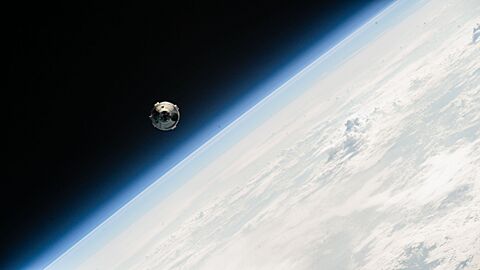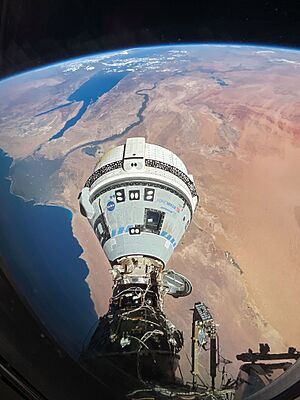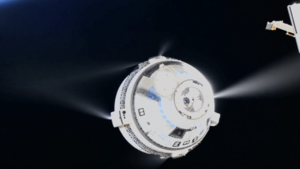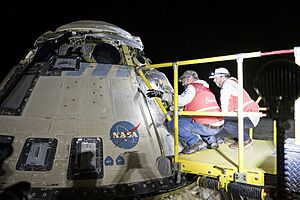Boeing Crew Flight Test facts for kids
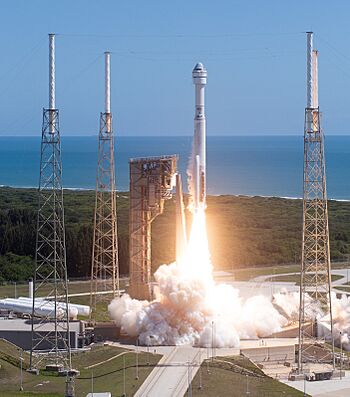
Boeing Starliner Spacecraft 3 Calypso launches on the Crew Flight Test atop an Atlas V rocket
|
|
| Names | Boe-CFT |
|---|---|
| Mission type | Flight test |
| Operator | Boeing Defense, Space & Security |
| Mission duration | Planned: 8 days Actual: 93 days, 13 hours and 9 minutes |
| Orbits completed | 1,464 |
| Spacecraft properties | |
| Spacecraft | Boeing Starliner Spacecraft 3 Calypso |
| Spacecraft type | Boeing Starliner |
| Manufacturer | Boeing Defense, Space & Security |
| Crew | |
| Crew size | 2 |
| Launching | |
| Landing | None |
| Start of mission | |
| Launch date | 5 June 2024, 14:52:15 UTC (10:52:15 am EDT) |
| Rocket | Atlas V N22 (AV-085) |
| Launch site | Cape Canaveral, SLC‑41 |
| Contractor | United Launch Alliance |
| End of mission | |
| Landing date | 7 September 2024, 04:01:35 UTC (6 September, 10:01:35 pm MDT) |
| Landing site | White Sands Space Harbor |
| Orbital parameters | |
| Reference system | Geocentric orbit |
| Regime | Low Earth orbit |
| Perigee | 315 km (196 mi) |
| Apogee | 324 km (201 mi) |
| Inclination | 51.66° |
| Docking with ISS | |
| Docking port | Harmony forward |
| Docking date | 6 June 2024, 17:34 UTC |
| Undocking date | 6 September 2024, 22:04 UTC |
| Time docked | 92 days, 4 hours, 30 minutes |
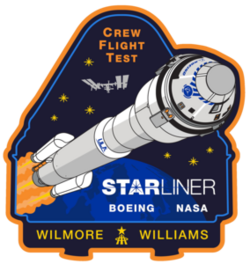 Boeing Crew Flight Test mission patch 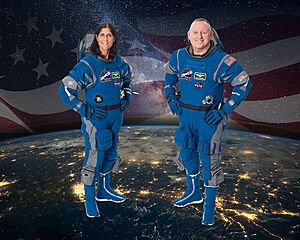 Williams (left) and Wilmore (right) Commercial Crew Development
|
|
The Boeing Crew Flight Test (Boe-CFT) was the first time the Boeing Starliner spacecraft carried astronauts into space. It launched on June 5, 2024. Two NASA astronauts, Barry E. Wilmore and Sunita Williams, flew from Cape Canaveral Space Force Station to the International Space Station (ISS).
The mission was supposed to last only eight days. However, Starliner's small steering thrusters had problems as it got close to the ISS. After looking into the issues for over two months, NASA decided it was too risky for Wilmore and Williams to return on Starliner.
Instead, the Starliner spacecraft came back to Earth without a crew on September 7, 2024. It landed safely at the White Sands Space Harbor in New Mexico. The astronauts returned to Earth later, on March 18, 2025, aboard a SpaceX Crew-9 spacecraft.
This mission faced many delays. It was first planned for 2017. Before this crewed flight, Starliner had two uncrewed test flights. These were called Boe-OFT in 2019 and Boe-OFT-2 in 2022.
Contents
Why the Mission Was Delayed
The first uncrewed test flight, Boe-OFT, was supposed to happen in 2017. But it was delayed because of problems during its development. When it finally launched in 2019, software errors stopped Starliner from reaching the ISS. This caused more delays for future flights.
The second uncrewed test, Boe-OFT-2, was delayed in 2021 due to valve problems. It successfully flew in 2022 and completed all its goals. In August 2023, Boeing announced that the first crewed flight would be delayed again. This was because of weak spots in the parachute system and some materials in the wiring that could catch fire. Boeing had to do many checks before another flight was allowed.
The Starliner Spacecraft
The Boe-CFT mission used the Starliner Calypso capsule. This was the second time this specific capsule flew into space. NASA announced in August 2020 that Boeing was getting the vehicle ready for this flight. They added new parachutes and airbags. The docking system on the Calypso capsule was also changed. This was to fit a new cover used during its return to Earth. This new cover was first used on the Boe-OFT-2 test flight.
The Astronauts
Because of all the delays, the astronauts assigned to this mission changed several times. Nicole Aunapu Mann was first chosen for this flight. She would have been the first woman to fly on the first crewed flight of an orbital spacecraft. But she was later moved to the SpaceX Crew-5 mission. There, she became the first female commander of a NASA Commercial Crew Program launch.
For health reasons, Eric Boe was replaced by Michael Fincke as the pilot in January 2019. Christopher Ferguson, a Boeing astronaut, was originally the commander. But he was replaced by NASA astronaut Barry E. Wilmore in October 2020. Ferguson said he needed to step down for family reasons.
In April 2022, NASA confirmed that this CFT mission would have two astronauts. These were Wilmore and Sunita Williams. Fincke trained as a backup pilot. Williams is the first woman to fly on the first crewed flight of an orbital spacecraft.
| Position | Launching astronaut | Landing astronaut |
|---|---|---|
| Commander | Expedition 71/72 Third spaceflight |
None |
| Pilot | Expedition 71/72 Third spaceflight |
None |
| When the Boeing Crew Flight Test mission launched, Wilmore and Williams were called ISS visitors. However, due to their extended stay, NASA later formally added them to the Expedition 71/72 crew. | ||
| Position | Astronaut | |
|---|---|---|
| Commander | ||
The Mission Journey
Launch Preparations
In 2023, after finding issues with the spacecraft's parachutes and wiring, the CFT launch was delayed to March 2024. By November 2023, NASA said the mission was on track for April 2024. Most of the flammable material was removed, and a test of the new parachute system was successful.
In February 2024, the Atlas V rocket was moved to its launch site. This started preparations for stacking the Starliner on top. In March 2024, the launch was moved from April 22 to early May. This was due to scheduling needs at the ISS. A launch date of May 6 was announced in April.
Work on the Starliner was finished on April 15. The spacecraft was then moved to the launch pad and placed on the Atlas V rocket the next day. The astronauts arrived at Kennedy Space Center on April 25. On the same day, the mission was officially approved to proceed.
On May 2, the SpaceX Crew-8 Dragon spacecraft moved to a different port on the ISS. This made room for Starliner, which could only dock at a specific port. The Atlas V rocket was then rolled out to its launch pad on May 4.
First Launch Attempt: May 6, 2024
The first try to launch CFT on May 6, 2024, was stopped about two hours before liftoff. This was because of a problem with an oxygen valve on the rocket's upper stage. Even though this problem had happened before and could be fixed easily, flight rules did not allow it with astronauts on board.
The launch team decided the valve needed to be replaced. This delayed the launch to May 17. The rocket had to be moved back to its assembly building. At the same time, NASA and Boeing found a small helium leak on Starliner's propulsion system. This caused further delays while teams checked the situation.
Second Launch Attempt: June 1, 2024
On May 24, NASA and Boeing decided to launch on June 1 without fixing the helium leak. They believed the spacecraft was safe to fly. This review also found a "design weakness" in the propulsion system. This could stop the spacecraft from returning to Earth in a very rare failure. Engineers then created a new way for the spacecraft to re-enter if this problem happened.
Astronauts Barry Wilmore and Sunita Williams returned to Kennedy Space Center on May 28. On May 29, teams from NASA, Boeing, and ULA confirmed they were ready for a June 1 launch.
Before this launch, a pump on the ISS that turns astronaut urine into drinking water broke. NASA decided to send a replacement pump on Starliner. To make space for the 64 kg pump, Wilmore's and Williams' personal bags were removed. They used spare clothes already on the ISS instead.
The second launch attempt on June 1 was stopped just under four minutes before liftoff. An automatic hold was triggered when one of the ground computers was too slow. This was caused by a faulty power supply unit connected to that computer. On June 2, the faulty part was replaced and worked normally.
Successful Launch: June 5, 2024
CFT finally lifted off on the Atlas V rocket on its third try. This happened on June 5 at 10:52 am EDT. The launch was from SLC-41 at Cape Canaveral Space Force Station, Florida. This was the 100th flight for the Atlas V rocket.
The rocket flew in a special setup with two solid rocket boosters. The boosters separated about 2 minutes and 20 seconds after liftoff. The main rocket stage kept firing for about 4 and a half minutes before separating. The second stage then fired for about 7 minutes. The astronauts said the second stage felt a bit shaky but was not uncomfortable.
The Starliner spacecraft separated from the second stage about 15 minutes after liftoff. To be extra safe, the rocket put the spacecraft into a path just below orbit. Starliner then used its own thrusters to enter orbit about 31 minutes after launch. The rocket placed the spacecraft perfectly into orbit.
Journey to the Space Station
After reaching orbit, the astronauts practiced controlling the spacecraft manually. They pointed antennas, solar panels, and used a star tracker. They also practiced speeding up and slowing down the spacecraft. These tests showed that the crew could control Starliner if there was an emergency. Astronaut Wilmore said Starliner performed very well.
Later on June 5, ground controllers found two more helium leaks in Starliner's propulsion system. To manage these leaks, they temporarily closed parts of the system. This turned off six of the spacecraft's 28 steering thrusters. The leaks were small, and Starliner still had enough helium for its mission. So, managers allowed it to continue to the ISS. A fourth, smaller leak was found after docking. NASA and Boeing realized this was likely a bigger problem with the system, not just one faulty part.
As Starliner got closer to the ISS, several of its steering thrusters stopped working. After two failed, Wilmore took manual control. He noticed the spacecraft was harder to control than before. NASA allowed docking even with these problems. Eventually, four thrusters failed, making it very hard to control the spacecraft's direction. The astronauts later said the situation was "very risky."
Wilmore could not fully control the capsule. But stopping the docking was also not safe, as the same thrusters were needed to return to Earth. The team at NASA Mission Control decided to try restarting the thrusters. Wilmore stabilized the capsule, then allowed Mission Control to restart the failed jets. Two thrusters came back online, but then a fifth one failed. A second restart brought all but one thruster back. This allowed Starliner to dock automatically as planned.
Starliner docked with the forward port of the ISS Harmony module on June 6. This was almost 27 hours after launch, including a delay caused by the thruster problem. Wilmore and Williams entered the station about two hours later. They joined the Expedition 71 crew members already there.
Time on the Space Station
On June 7, the CFT astronauts spent their first full day on the ISS. They moved cargo and emergency equipment into and out of Starliner. They were helped by other ISS crew members. One important item they unpacked was a new pump for the station's toilet system. This system turns astronaut urine into drinking water. The old pump had broken on May 29. By the next day, the new pump was installed and working.
On June 8, the crew tested Starliner's ability to be a "safe haven" in an emergency. This means it could protect the crew for a long time or allow them to leave the station quickly. This is a must for any crewed spacecraft visiting the ISS. The CFT astronauts, along with two other crew members, also tested living conditions inside Starliner with four people. On June 9, the CFT crew continued checking Starliner as part of their test goals. The spacecraft was then put into a low-power mode. It was meant to stay this way until it was time to undock.
From June 10, the CFT crew started helping with general ISS maintenance and research. They measured their health signs. Wilmore worked on a computer for science experiments. Williams installed hardware for a space fire study. They also talked to people on Earth, including a call to a school named after Sunita Williams.
On June 11, the astronauts worked on health-related tasks. Wilmore organized supplies for human research. Williams worked on collecting microbe samples and studying their genes. They also had an event with Wilmore's university. On June 12, Wilmore checked cargo and worked on the station's bathroom. Williams continued her gene study. On June 13, the CFT crew helped prepare for a planned spacewalk. They helped the other astronauts get into their suits. When the spacewalk was canceled, they helped them get out.
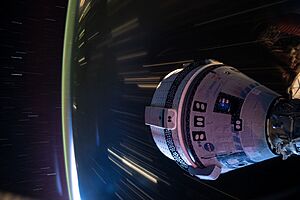
On June 14, their undocking date was moved to June 22. The CFT astronauts talked with Boeing managers about the end of the mission. They then went into Starliner to review its operations. On June 15 and 16, they did tasks for their CFT mission and helped the ISS crew. On June 17, Williams worked on maintenance and prepared a plant habitat for experiments. On June 18, she continued her gene study. Wilmore spent these two days studying how liquids flow in space.
NASA said that since their arrival on June 6, Wilmore and Williams had done half of all the hands-on research time on the ISS. This gave their crewmates more time to prepare for another spacecraft's departure.
While Starliner was docked, NASA and Boeing continued to check its performance. They focused on the helium leaks and thruster problems. NASA delayed the mission's end several times to keep testing the spacecraft in space. This was important because the service module is thrown away when it returns to Earth. So, this was their only chance to collect data from it.
On June 10, NASA reported a fifth small helium leak and a new problem: a valve that did not close properly. On June 15, the spacecraft was powered on for a thruster test. Seven of eight thrusters worked normally. This included four of the five that had failed during docking. One thruster, which could not be fixed, was not used again. This test also showed that all five helium leak rates had decreased. The cause of the helium and thruster problems was still unknown. NASA managers thought the intense movements during docking might have caused the problems.
In July, a team from NASA and Boeing started ground tests in New Mexico. They tested a thruster that was planned for a future Starliner mission. They copied the conditions Calypso experienced from launch to docking. They also simulated five return sequences. These tests finished by July 18.
During these tests, the team was able to make the thrusters fail in the same way. When the test thruster was taken apart, they found a Teflon seal was bent. Heat seemed to cause these seals to swell and block the fuel flow. However, when these tests were done on the Starliner in orbit, the same problem was not seen. Even thrusters that had lost power before worked almost normally. This suggested the seals might not be the main cause.
After these results, some NASA engineers were still worried. There was no agreement that Wilmore and Williams should return on Starliner. Boeing, however, felt confident in Starliner. They believed it was safe to bring the astronauts home. Wilmore and Williams later said they privately doubted Starliner could bring them back safely.
Because of this uncertainty, NASA delayed the August 18 launch of its SpaceX Crew-9 mission to September 24, 2024. Starliner was using the docking port needed by Crew-9. So, Starliner had to undock before Crew-9 could arrive. NASA also thought about ways to bring Williams and Wilmore home if Starliner was unsafe. This included launching Crew-9 with two empty seats. However, NASA said this would add more risks. Starliner would need a software update to fly without a crew.
Uncrewed Return to Earth
NASA had first planned for Starliner to undock and return to Earth on June 14. This would have been an eight-day stay. The landing was delayed many times by NASA and Boeing. They needed to find out why the helium leaked and the thrusters failed. On June 28, NASA announced that Starliner would not be approved to return until its thruster problems were solved or better understood.
NASA and Boeing first said Starliner could stay docked for up to 45 days. Later, they said its batteries would allow a stay of up to 90 days.
On August 24, NASA announced that it was too risky to bring Wilmore and Williams back on Starliner. The astronauts would instead return in March 2025 on a Crew Dragon. They would join members of the SpaceX Crew-9 mission. That mission launched with two astronauts instead of four. This left two empty seats for Williams and Wilmore.
The ISS only has two main docking ports. So, Starliner had to undock before Crew-9 could dock. Each astronaut must have a "lifeboat" in case of an emergency on the station. SpaceX created a special setup for the Dragon spacecraft. Up to three crew members could strap themselves to the floor, where cargo is usually stored. This area would be covered with foam padding.
Starliner's problems and the astronauts' longer stay got a lot of media attention. Boeing did not like reporters saying the astronauts were "stuck" in space. After NASA decided to end the Starliner test flight without a crew, Boeing did not answer questions from journalists. They only released short statements. Reporters argued that NASA and Boeing should have been more open about the mission.
Under Starliner's original plan, the trip home would have started with the astronauts closing the hatch. Then, about three hours of preparations for undocking. Once undocked, the capsule would have flown around the station. It would then fire its thrusters to start the trip back to the western United States. The capsule would have landed about six and a half hours later.
Instead, the uncrewed Starliner undocked on September 6 at 10:04 pm UTC. It performed a simpler maneuver to move away from the ISS. It mostly used its forward-facing thrusters, which had no problems during docking. The spacecraft then fired its engines to begin its return to Earth. This was done at a safe distance from the station.
Starliner re-entered Earth's atmosphere about six hours after undocking. It deployed three parachutes, slowing the capsule down to about 4 miles per hour. Before landing, six airbags inflated to cushion the landing. It landed at White Sands Space Harbor in New Mexico on September 7 at 04:01:35 UTC (September 6, 10:01:35 pm MDT, local time). All possible landing sites were in the western United States. This allowed the service module to be dropped for a controlled burn-up over the Pacific Ocean.
During its return, Starliner had two new technical problems. These were not related to its earlier issues. There was a brief glitch in its navigation system. Also, one of the 12 thrusters used to steer the capsule during re-entry failed to ignite consistently. This thruster was part of the crew capsule itself. It was separate from the thruster system in the service module that had problems in orbit.
Images for kids
See also
 In Spanish: Boe-CFT para niños
In Spanish: Boe-CFT para niños
- Development of the Commercial Crew Program
- SpaceX Dragon 2
- Crew Dragon Demo-2, SpaceX's first crewed mission of their capsule


